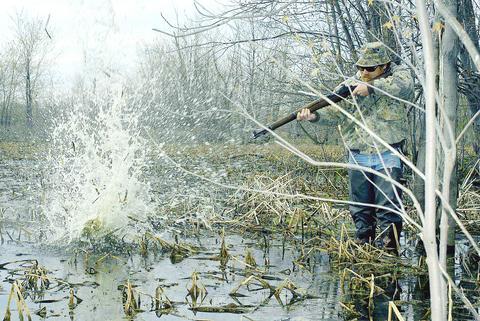The hunter's prey darted into the shadows, just out of reach of Henry Demar's gun.
"Come on, stand up and be counted," Demar muttered. "There was a ripple that came out of the weeds. There's something out there."

PHOTO: NY TIMES
Dressed in camouflage, gripping his .357-caliber Magnum, Demar was primed to shoot. But this time, no such luck. With a flick of its tail, his quarry -- a slick, silvery fish -- was gone.
Fish shooting is a sport in Vermont, and every spring, hunters break out their artillery -- high-caliber pistols, shotguns, even AK-47s -- and head to the marshes to exercise their right to bear arms against fish.
It is a controversial pastime, and Vermont's fish-and-wildlife regulators have repeatedly tried to ban it. They call it unsportsmanlike and dangerous, warning a bullet striking water can ricochet across the water like a skipping stone.
But fish shooting has survived, a cherished tradition for some Vermont families and a novelty to some teenagers and twenty-somethings. Every spring, fixated fish hunters climb into trees overhanging the water or perch on the banks of marshes that lace Lake Champlain, on Vermont's northwest border.
"They call us crazy, I guess, to go sit in a tree and wait for fish to come out," said Dean Paquette, 66, as he struggled to describe the fish-shooting rush. "It's something that once you've done it ...."
Paquette, a retired locomotive engineer, has passed fish shooting on to his children and grandchildren, including his daughter, Nicki, a nurse. "You have to be a good shot," said Paquette, 31, who started shooting at age six. "It's a challenge. I think that's why people do it."
Her 87-year-old great uncle, Earl Picard, is so hooked that, against the better judgment of his relatives, he frequently drives 1000km from his home in Newport to Lake Champlain. Picard still climbs trees, although "most of the trees that I used to climb in are gone," he said. "You can sit up there in the sun and the birds will come and perch on your hat and look you in the eye."
There is art, or at least science, to shooting fish, aficionados say. Most fish hunters do not want to shoot the actual fish, because then "you can't really eat them," Paquette said. "They just kind of shatter."
Instead, said Demar, "you try to shoot just in front of the fish's nose or head." The bullet torpedoes to the marsh bottom and creates "enough concussion that it breaks the fish's air bladder and it floats to the surface."
Often the target is a female fish come to spawn in shallow water, accompanied by several male acolytes who might also be killed, or stunned, by the concussion.
"If you shoot a high-powered rifle, you can get a big mare and six or seven little bucks," Paquette said.
Permitted from March 25 to May 25, and only on Lake Champlain, fish shooting has probably existed for a century. (Picard was 10 when he started.) It also used to be legal in the state of New York, which also borders the huge apostrophe-shaped lake.
State officials say that fish shooting disturbs nesting birds and that killing spawning females could endanger the northern pike population (although so far there is no evidence it has).
Worst of all, state officials say, many shooters do not retrieve all the fish they kill. They leave behind fish they cannot find or do not want to wade after and fish that exceed the state's five-pike-a-day limit or fall under the minimum length for northern pike. Marcelle recently found 18 dead fish left to rot.
Two dead fish recently greeted Demar and his companions at the marsh, a species he called mudfish. There were some frolicking muskrats, chickadees in the ash and willow trees, and shell casings from an 8mm Mauser. ("Oh, that's made for blowing them out of the water," Rushford said.)
There were not, however, enough live fish to shoot. So Demar tested his gun on a log in the water, and spray shot up.
"I got a little water on my sunglasses," he said sheepishly. "That's the thing about pickerel shooting. Afterward, you have to turn away, or you get sprayed in the face."

Last week gave us the droll little comedy of People’s Republic of China’s (PRC) consul general in Osaka posting a threat on X in response to Japanese Prime Minister Sanae Takaichi saying to the Diet that a Chinese attack on Taiwan may be an “existential threat” to Japan. That would allow Japanese Self Defence Forces to respond militarily. The PRC representative then said that if a “filthy neck sticks itself in uninvited, we will cut it off without a moment’s hesitation. Are you prepared for that?” This was widely, and probably deliberately, construed as a threat to behead Takaichi, though it

Nov. 17 to Nov. 23 When Kanori Ino surveyed Taipei’s Indigenous settlements in 1896, he found a culture that was fading. Although there was still a “clear line of distinction” between the Ketagalan people and the neighboring Han settlers that had been arriving over the previous 200 years, the former had largely adopted the customs and language of the latter. “Fortunately, some elders still remember their past customs and language. But if we do not hurry and record them now, future researchers will have nothing left but to weep amid the ruins of Indigenous settlements,” he wrote in the Journal of

Even after years in business, weekend tables here can be booked out a month in advance. The price point far exceeds its competitors. Granted, expectations are soaringly high, but something here failed to hit the high notes. There are a few telltale signs that a restaurant relies solely on outstanding food to create the experience, no gimmicks or distractions needed. La Mole is such a restaurant. The atmosphere is food-forward, with an open kitchen center stage. Our tables are simple; no candles, no dim lighting, no ambient music. The menu is brief, and our waiter directs most

If China attacks, will Taiwanese be willing to fight? Analysts of certain types obsess over questions like this, especially military analysts and those with an ax to grind as to whether Taiwan is worth defending, or should be cut loose to appease Beijing. Fellow columnist Michael Turton in “Notes from Central Taiwan: Willing to fight for the homeland” (Nov. 6, page 12) provides a superb analysis of this topic, how it is used and manipulated to political ends and what the underlying data shows. The problem is that most analysis is centered around polling data, which as Turton observes, “many of these